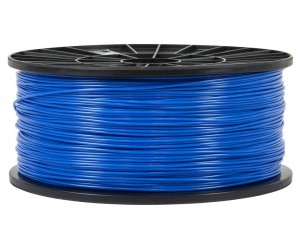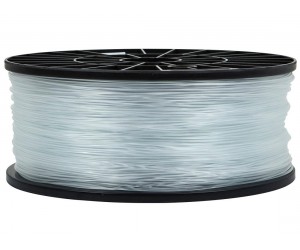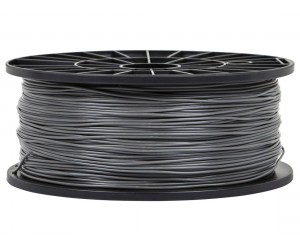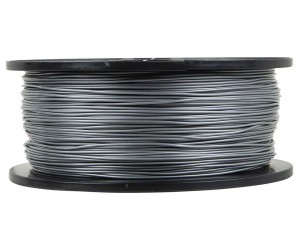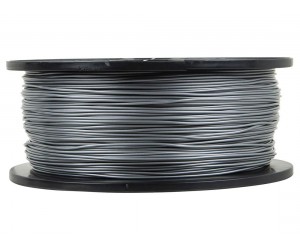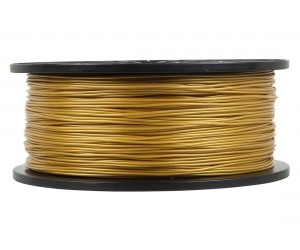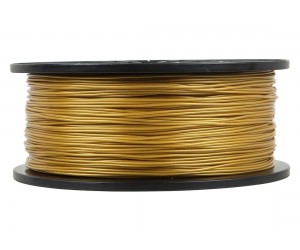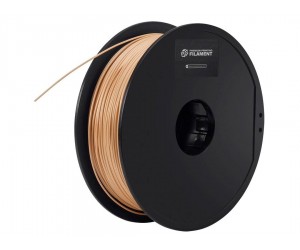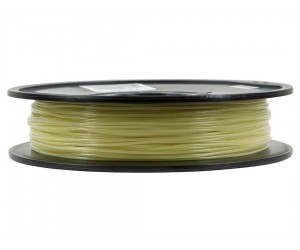Tech
Premium 3D Printer Filament PLA 1.75mm 1kg/spool, Blue
PLA is a good choice for a printing material if you are looking for high accuracy and high resolution. It extrudes at lower temperatures, does not require a heated base, and has a very low shrinkage rate (0.3%). PLA is harder than ABS, but is therefore also a bit more brittle. This 1 kg spool features a thickness of 1.75mm ±0.10mm, with a roundness variation of only 0.03mm. It has a nominal processing temperature of 210° C (410°F). Thickness and roundness factors are laser measured at the factory to ensure accuracy over the entire length of the filament. The negatives of using PLA is that it is vulnerable to degradation from moisture, sunlight, and heat. Additionally, it is more prone to overheating during processing, which can cause dripping and drooping if it gets too hot.Premium 3D Printer Filament PLA 1.75mm 1kg/spool, Crystal Clear
PLA is a good choice for a printing material if you are looking for high accuracy and high resolution. It extrudes at lower temperatures, does not require a heated base, and has a very low shrinkage rate (0.3%). PLA is harder than ABS, but is therefore also a bit more brittle. This 1 kg spool features a thickness of 1.75mm ±0.10mm, with a roundness variation of only 0.03mm. It has a nominal processing temperature of 210°C (410°F). Thickness and roundness factors are laser measured at the factory to ensure accuracy over the entire length of the filament. The negatives of using PLA is that it is vulnerable to degradation from moisture, sunlight, and heat. Additionally, it is more prone to overheating during processing, which can cause dripping and drooping if it gets too hot.Premium 3D Printer Filament PLA 1.75mm 1kg/spool, Gray
PLA is a good choice for a printing material if you are looking for high accuracy and high resolution. It extrudes at lower temperatures, does not require a heated base, and has a very low shrinkage rate (0.3%). PLA is harder than ABS, but is therefore also a bit more brittle. This 1 kg spool features a thickness of 1.75mm ±0.10mm, with a roundness variation of only 0.03mm. It has a nominal processing temperature of 210°C (410°F). Thickness and roundness factors are laser measured at the factory to ensure accuracy over the entire length of the filament. The negatives of using PLA is that it is vulnerable to degradation from moisture, sunlight, and heat. Additionally, it is more prone to overheating during processing, which can cause dripping and drooping if it gets too hot.Premium 3D Printer Filament PLA 1.75mm 1kg/spool, Pink
PLA is a good choice for a printing material if you are looking for high accuracy and high resolution. It extrudes at lower temperatures, does not require a heated base, and has a very low shrinkage rate (0.3%). PLA is harder than ABS, but is therefore also a bit more brittle. This 1 kg spool features a thickness of 1.75mm ±0.10mm, with a roundness variation of only 0.03mm. It has a nominal processing temperature of 210°C (410°F). Thickness and roundness factors are laser measured at the factory to ensure accuracy over the entire length of the filament. The negatives of using PLA is that it is vulnerable to degradation from moisture, sunlight, and heat. Additionally, it is more prone to overheating during processing, which can cause dripping and drooping if it gets too hot.Premium 3D Printer Filament PLA 1.75mm 1kg/spool, Silver
PLA is a good choice for a printing material if you are looking for high accuracy and high resolution. It extrudes at lower temperatures, does not require a heated base, and has a very low shrinkage rate (0.3%). PLA is harder than ABS, but is therefore also a bit more brittle. This 1 kg spool features a thickness of 1.75mm ±0.10mm, with a roundness variation of only 0.03mm. It has a nominal processing temperature of 210°C (410°F). Thickness and roundness factors are laser measured at the factory to ensure accuracy over the entire length of the filament. The negatives of using PLA is that it is vulnerable to degradation from moisture, sunlight, and heat. Additionally, it is more prone to overheating during processing, which can cause dripping and drooping if it gets too hot.Premium 3D Printer Filament ABS 1.75mm 1kg/spool, Silver
This 1 kg spool features a thickness of 1.75mm ±0.10mm, with a roundness variation of only 0.05mm. It has a nominal processing temperature of 230°C (446°F). Thickness and roundness factors are laser measured at the factory to ensure accuracy over the entire length of the filament. The negatives of using ABS is that it can give off a white smoke with a concentrated odor. It is best to ensure that the printing room is well ventilated when using ABS. Additionally, it has a high moisture absorption rate. Depending on the overall humidity level of the printing environment, an opened spool can absorb enough moisture after a couple of days that high temperature printing could cause bubbles or pocks in the extrusion. It is therefore recommended to not open a spool until you are ready to print and to store any unused portion with with silca gel and/or an active dehumidifier to reduce the amount of moisture it can absorb.Premium 3D Printer Filament PLA 1.75mm 1kg/spool, Gold
PLA is a good choice for a printing material if you are looking for high accuracy and high resolution. It extrudes at lower temperatures, does not require a heated base, and has a very low shrinkage rate (0.3%). PLA is harder than ABS, but is therefore also a bit more brittle. This 1 kg spool features a thickness of 1.75mm ±0.10mm, with a roundness variation of only 0.03mm. It has a nominal processing temperature of 210°C (410°F). Thickness and roundness factors are laser measured at the factory to ensure accuracy over the entire length of the filament. The negatives of using PLA is that it is vulnerable to degradation from moisture, sunlight, and heat. Additionally, it is more prone to overheating during processing, which can cause dripping and drooping if it gets too hot.Premium 3D Printer Filament ABS 1.75mm 1kg/spool, Gold
ABS is one of the most commonly used filament types in 3D printing. It has a high tensile strength and good overall toughness. It has a low density and is softer than PLA, which means lower weight and lower cost when printing large models. Hardness is such that no white dot appears when bending. This 1 kg spool features a thickness of 1.75mm ±0.10mm, with a roundness variation of only 0.05mm. It has a nominal processing temperature of 230°C (446°F). Thickness and roundness factors are laser measured at the factory to ensure accuracy over the entire length of the filament. The negatives of using ABS is that it can give off a white smoke with a concentrated odor. It is best to ensure that the printing room is well ventilated when using ABS. Additionally, it has a high moisture absorption rate. Depending on the overall humidity level of the printing environment, an opened spool can absorb enough moisture after a couple of days that high temperature printing could cause bubbles or pocks in the extrusion. It is therefore recommended to not open a spool until you are ready to print and to store any unused portion with with silca gel and/or an active dehumidifier to reduce the amount of moisture it can absorb.Premium 3D Printer Filament PLA 1.75MM .5kg/spool, Wood
Laywood is an extrusion material made from 40% recycled wood combined with polymer binders to allow it to melt and print like any other material. It doesn't warp, doesn't shrink, and doesn't require a heated print bed. The finished product can be sanded like ordinary wood and even smells like wood. The color can be varied from light to dark by increasing the printing temperature through its 190 ~ 220°C printing temperature range.3D Printer Filament PVA 1.75MM .5kg/spool, Dissolvable
Support elements are required when printing objects with an overhang. Normally these are printed using the same material as the main object, which requires you to painstakingly remove the supports. This can be time consuming and can result in damage to the printed object, requiring you to restart the entire process. This 1.75mm PVA filament is designed to serve as the support material when printing with PLA as the main material. The PVA material dissolves in water, so trimming the finished product is as easy as dropping it into a bucket of water. It comes on a 0.5kg spool and prints at temperatures between 190 ~ 200°C.







